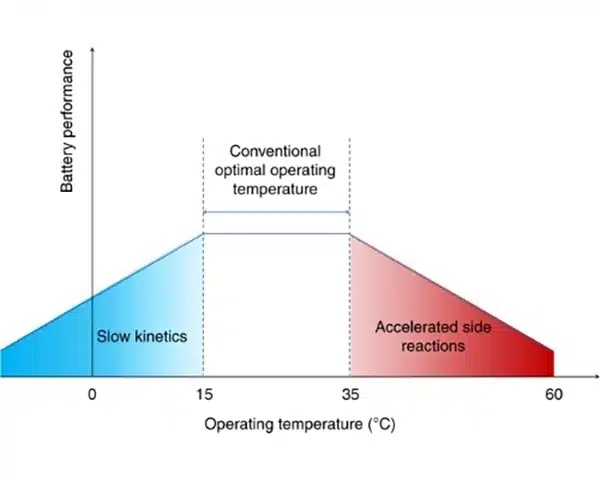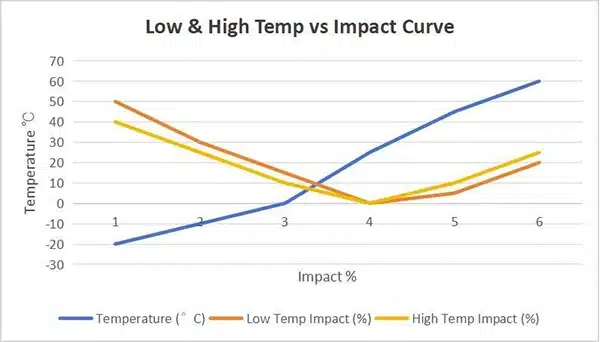In summer, mobile phones get hot and lose battery quickly, and in winter, electric cars can’t run far. The impact of temperature on lithium batteries is self-evident. So, how does temperature affect battery performance and life? In this article, you can find the answers to the best temperature range for lithium batteries and how high and low temperatures affect lithium batteries.
Table of Contents
ToggleIdeal operating range of lithium batteries

Lithium-ion batteries are the core power source for our daily electronic devices and electric vehicles, and temperature is a key factor affecting their performance, life and even safety.
Just like the temperature range that humans feel most comfortable in, lithium batteries also have a golden temperature range where they perform best and age the slowest. The generally accepted ideal range is 15°C to 25°C (60°F to 77°F). Within this temperature range, the battery can perform optimally and the aging rate of its internal materials is the slowest, which helps to extend the overall life of the battery.
The recommended charging temperature range for lithium batteries is 0℃ ~ 45℃. However, we recommend charging in temperature intervals: in the range of 0 ~ 10℃, the charging current is 0.2C; in the range of 10 ~ 45℃, the charging current is 1C.
The recommended discharge temperature range for lithium batteries is -20℃ ~ 60℃. Similarly, below 0℃, we also recommend discharging with a small rate current, such as 0.2C.
Within the optimal operating temperature range of 15°C ~ 25°C, the electrochemical reaction responsible for energy storage and release inside the lithium battery is most efficient, and its internal resistance is also at a relatively low level, reducing energy loss.
Why temperature is important
Temperature has an important impact on lithium batteries. Temperature directly controls the speed of reaction, which is the most direct impact. When the temperature is moderate, the reaction speed is just right, and the battery can output energy efficiently and stably.
Temperature changes the energy output efficiency and power through changes in internal resistance. Especially at low temperatures, the internal resistance decreases, just like when the road is icy, it becomes difficult for current to pass.
Temperature changes the state of the electrolyte, which is the key to ion transport and is greatly affected by temperature. At low temperatures, the electrolyte becomes more and more viscous, like a highway turning into a muddy road. In severe cases, it may even be close to solidification, greatly hindering the free speed of ions.
Temperature affects the stability of materials inside the battery. High temperature accelerates the chemical decomposition and physical structure destruction of materials, such as reducing the activity of electrode materials and the performance of diaphragms.
Temperature has a comprehensive impact on the battery, profoundly affecting it from the inside out, from the chemical to the physical level.
Table 1: Effect of temperature on lithium battery capacity
| Temperature (°C) | Capacity retention rate (%) |
| -20 | 50 |
| -10 | 70 |
| 0 | 85 |
| 25 | 100 |
| 45 | 95 |
| 60 | 80 |
Note: At low temperatures (-20°C), the capacity drops significantly, leaving only 50%; at high temperatures (60°C), the capacity retention rate also drops to 80%.
Table 2: Effect of temperature on lithium battery lifespan
| Temperature (°C) | Cycle life (times) |
| -10 | 300 |
| 0 | 500 |
| 25 | 1000 |
| 45 | 700 |
| 60 | 400 |
Effects of high temperature on lithium batteries
High temperatures can often cause serious or even irreversible damage to lithium batteries.
When the temperature starts to rise, the instantaneous output power of the battery may sometimes even increase slightly due to the acceleration of chemical reactions and the slight reduction of internal resistance. In the long term or at higher temperatures, performance degradation will be inevitable because the internal structure of the battery is quietly being destroyed.
High temperature will sharply accelerate various side reactions inside the battery, such as electrolyte decomposition, electrode material passivation, active material loss, etc. These processes will cause the battery capacity to decay at a faster rate.
High temperatures not only accelerate aging, but also directly lead to permanent loss of effective battery capacity. Even if the temperature returns to normal, this lost capacity cannot be restored.
High temperatures even bring worrying safety risks, such as increasing the risk of short circuits, increasing the chance of battery bulging, and even the risk of thermal runaway.
Effects of low temperature on lithium batteries

Unlike the material damage and safety risks caused by high temperature, the impact of low temperature on lithium batteries is more like putting them into hibernation, which is mainly manifested in a sharp decline in performance. Although some effects can be recovered after the temperature rises, charging at low temperature may cause permanent damage.
The battery seems to be not as durable as before, and the power is dropping very fast. This is because low temperature reduces the rate of chemical reactions inside the battery, making it difficult for lithium ions to move, which reduces the effective amount of power that the battery can release. This capacity loss is usually temporary. When the battery temperature returns to the normal range, its available capacity will mostly be restored.
Never charge lithium batteries in a low temperature environment. The BMS will cut off the battery charging, causing the device to stop working. However, it may cause permanent damage from lithium precipitation. Even more dangerous is that these metallic lithium dendrites may pierce the diaphragm and cause an internal short circuit, greatly increasing the risk of thermal runaway, fire, or even explosion.
Temperature considerations in special scenarios
Optimal charging temperature range: It is generally recommended to charge between 10°C and 45°C (50°F and 113°F). Within this range, the battery can receive charge more safely and efficiently.
Once again, it is forbidden to charge below freezing point. Please let it warm up naturally at room temperature for a while before charging.
Optimum Storage Temperature: The ideal long-term storage environment is a cool, dry place. A constant temperature of around 15°C (60°F) is considered ideal. Avoid storing on a windowsill in direct sunlight or in a car during the hot summer months.
We recommend keeping the battery charge around 40% to 60% for long-term storage. This intermediate state of charge can significantly slow down the aging of the battery.
How to take care of your lithium battery
Now that we know how temperature affects lithium batteries, we can take better care of our batteries, extend their life, and ensure their safety through some simple daily habits. Here are some specific, actionable suggestions:
Stay away from extreme environments. Avoid placing the device near heat sources such as heaters and ovens. When parking, try to choose a cool place, or take the device with you, and do not leave it in a closed and stuffy car. In cold weather, try to avoid exposing the device to the outdoors for a long time, or leaving it in a cold car overnight.
Try to charge your device at room temperature (approximately 10°C – 30°C / 50°F – 86°F). This is the most comfortable and efficient charging temperature range.
Try to avoid high-load operations while charging, such as playing large mobile games, running complex computer software, or turning on the air conditioner for a long time while the electric car is fast charging.
Conclusion
Temperature is a key factor affecting the performance, service life and safety of lithium-ion batteries. Too high or too low temperatures, as well as improper temperature management (especially during charging), can cause varying degrees of damage, some of which are even irreversible.
Visit Hongyitai to learn about our advanced lithium batteries. We take actual operating temperature into consideration to meet the needs of various harsh environments and provide reliable power for your devices.
FAQs
When the temperature of lithium-ion batteries exceeds 45°C (113°F), their performance and life will be significantly affected. If it continues to rise to 60°C (140°F), it will cause electrolyte decomposition and thermal runaway, leading to serious safety issues such as fire or explosion. Therefore, it is necessary to avoid operating or charging in an environment above 45°C.
The optimal operating temperature range of LiFePO4 battery is 0°C to 50°C (32°F to 122°F). Compared with other lithium-ion batteries, it performs well under high temperature conditions and has a 6000+ cycle life, making it suitable for applications such as energy storage systems and electric vehicles.
When the ambient temperature is below 0°C (32°F), the performance of lithium batteries will be significantly reduced, and their usable capacity may be reduced to 70%-80% of the rated value. When the temperature is below -20°C (-4°F), the chemical reaction may be hindered, causing permanent damage or even failure.
